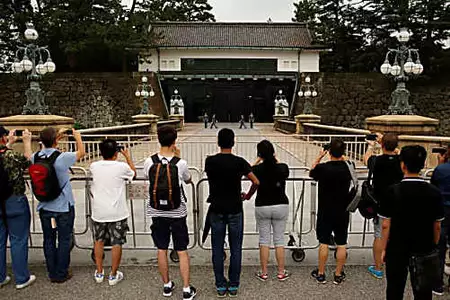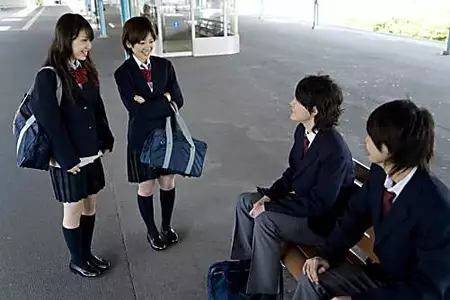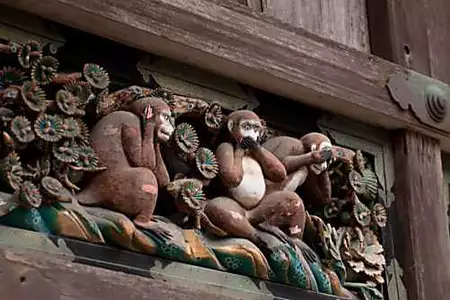Shoji Matsuura
- MARKETS
- 113.68 ¥/$ (5 p.m.)
NATIONAL
‘Miyadaiku’ carpenter laments loss of traditional knowledge
BY ASAKO MURAKAMIhoji Mat
HOFU, Yamaguchi Pref. —Shoji Matsuura communicates with the dead.
The 71-year-old’s conversation partners are carpenters of centuries ago, and he gets to speak with them every time he restores the shrines and temples they built.
 |
| Shoji Matsuura in the main hall of Kokubunji Temple in Hofu, Yamaguchi Prefecture |
Matsuura is the only one of the few “miyadaiku” — carpenters who handle traditional Japanese structures — who specializes in restoring shrines and temples designated as national treasures and cultural assets.
Matsuura himself was designated a “national asset as a technical expert” in 1999 by the central government for having woodwork techniques that need to be preserved. He gets his greatest pleasure from dismantling structures, as he discovers the wisdom and various techniques that went into their construction.
“I am thrilled when I think of what will appear next,” he said in a recent interview in Hofu, where he is working as a master carpenter to restore the main hall of Kokubunji temple, an important cultural property. The work, begun in 1998, is expected to be completed in 2004.
A miyadaiku for over 50 years, Matsuura has been involved in restoring five national treasures and 28 cultural assets across the country. Many were built in the Kamakura (1192-1333) and Muromachi (1392-1573) periods.
Matsuura said he is constantly impressed by the sophisticated techniques of carpenters of those periods, from which shrines and temples have lasted hundreds of years due to the high quality of timber used, the use of moisture-prevention measures and steps taken to make them earthquake-proof.
Although various woodwork tools have been developed over the centuries, Matsuura said they have contributed to a decline in the quality of techniques and structures built.
“The techniques for constructing wooden buildings in the past greatly surpass those of today,” Matsuura said. “Wood used to be broken along the grain. But once people started using a saw, they ignored the grain and failed to make the most of wood’s characteristics. People used their brains more when fewer tools were available.”
While Western buildings have often been described as coming from a culture of stone, Japan is a culture with foundations of wood.
The master carpenter says the best examples of Japanese architecture can be seen in the shrines and temples of the Kamakura and Muromachi periods, which saw a peak in construction techniques and the quest for beauty. Many of these past techniques are still being discovered.
While Matsuura does not completely shun modern buildings, he “feels a sense of crisis” over the possible extinction of this specialist knowhow.
Top-level knowledge and skill is still needed for further restoration work, as the restoration of some shrines and temples has not always been exact.
The number of Miyadaiku have dwindled over the decades, with most leaving the trade as they could not make a living. While recently some young people have showed interest, the job requires more time and patience than they usually think, according to Matsuura.
“Learning from books does not really help in this world. You have to learn it on the job.”
Securing enough specialized carpenters, however, will not fully solve the problem of preserving Japan’s traditional structures, admired at home and abroad.
Matsuura said it is becoming harder to lay hands on high-quality wood because of the deterioration of the country’s forests.
“Replanted trees are not good as they are coarse-grained,” he said. “Those which have stood for many years withstanding wind and rain are those that are good quality.
“This might apply to people as well.”











![[Gallery] After 75 Years Apart, These Women Discover A Life-Changing Letter [Gallery] After 75 Years Apart, These Women Discover A Life-Changing Letter](https://images.outbrain.com/Imaginarium/api/uuid/622dcbad5229929f894e8466c1760a7d96f73d190161afe67220986bf7b98c63/300/200/1.0/webp)


![20 Eerie Facts About Life In North Korea [Gallery] 20 Eerie Facts About Life In North Korea [Gallery]](https://images.outbrain.com/Imaginarium/api/uuid/d61dc6c99978b2e9484589dda9ef954c538b1b8da65429104184b62b1d9ee86d/300/200/1.0/webp)

Comments
Post a Comment